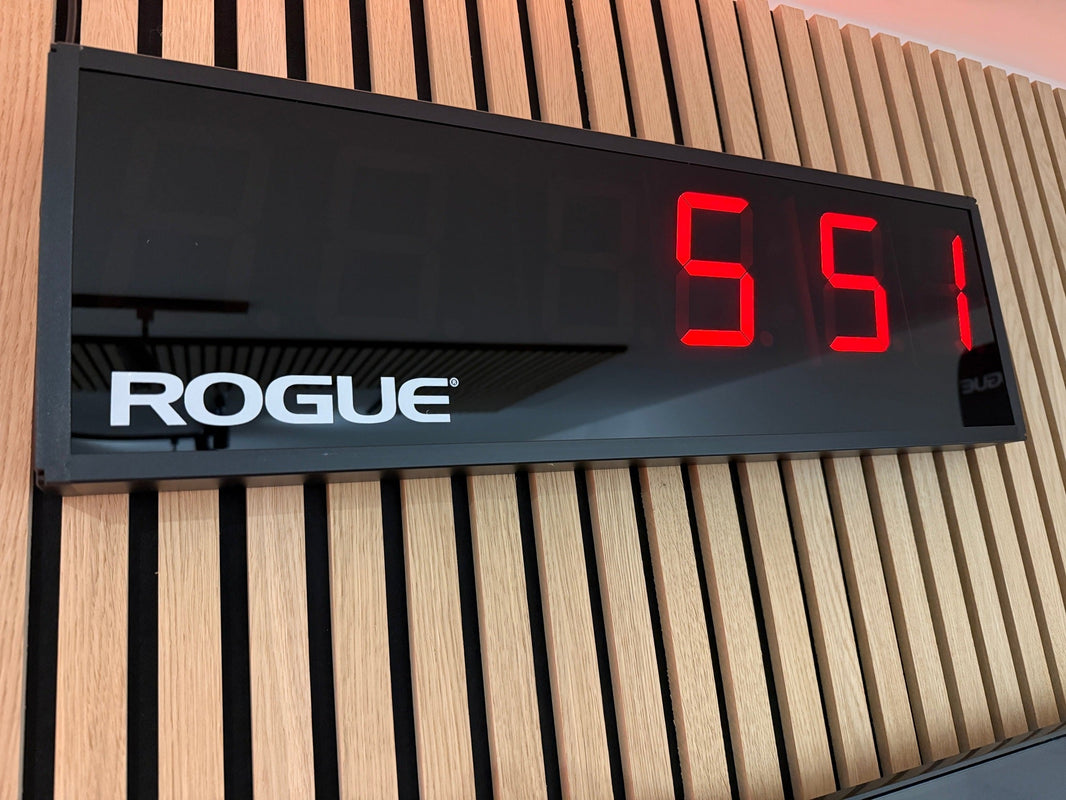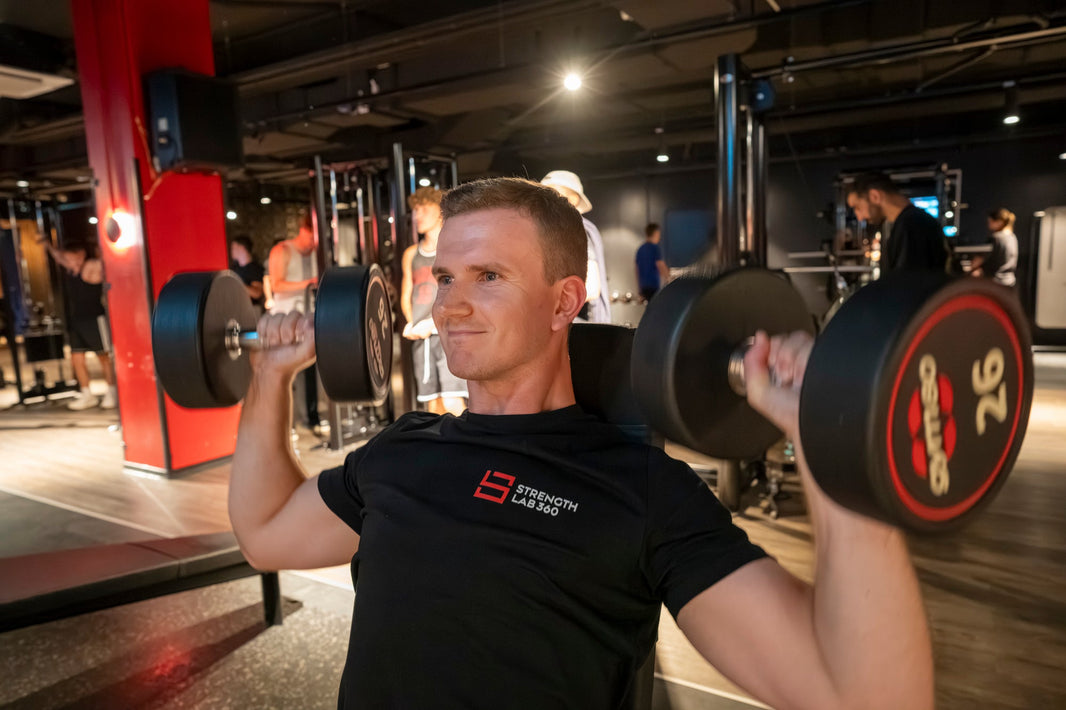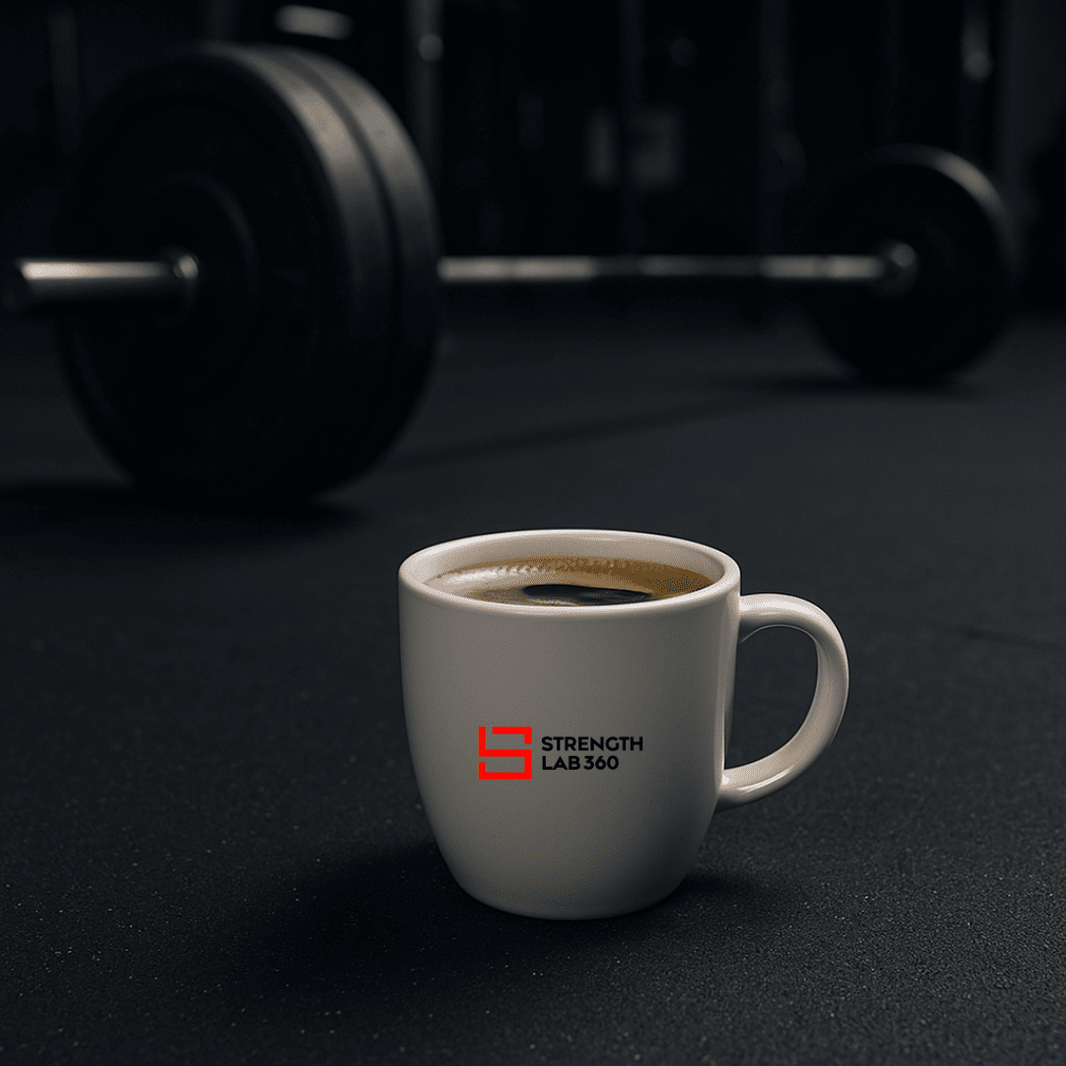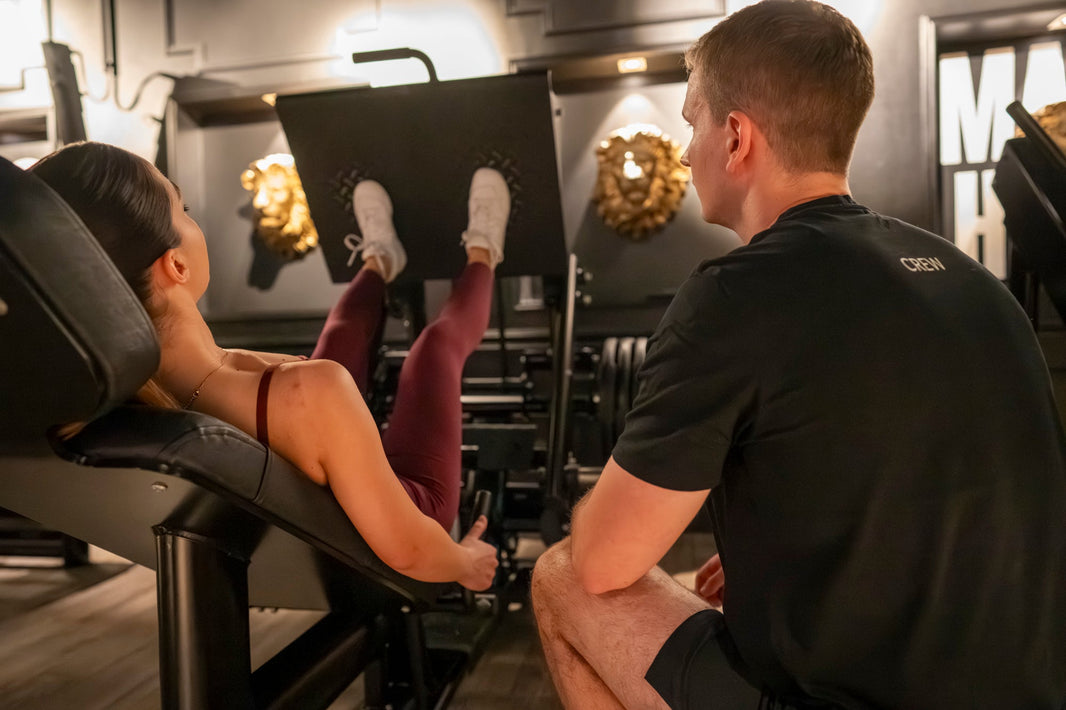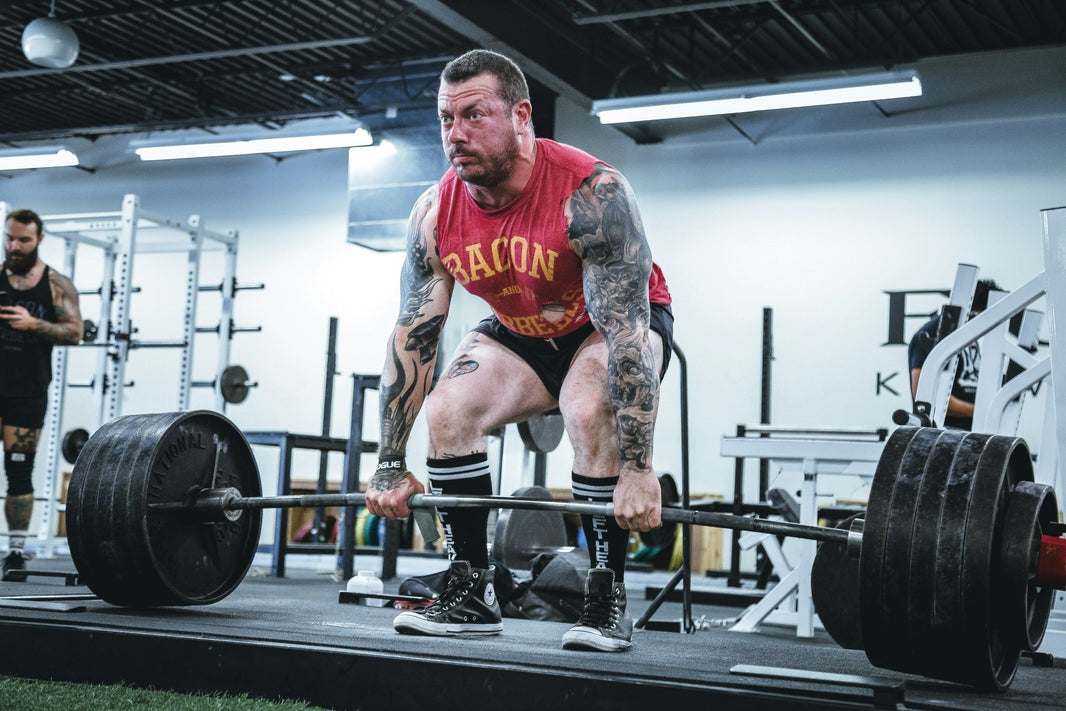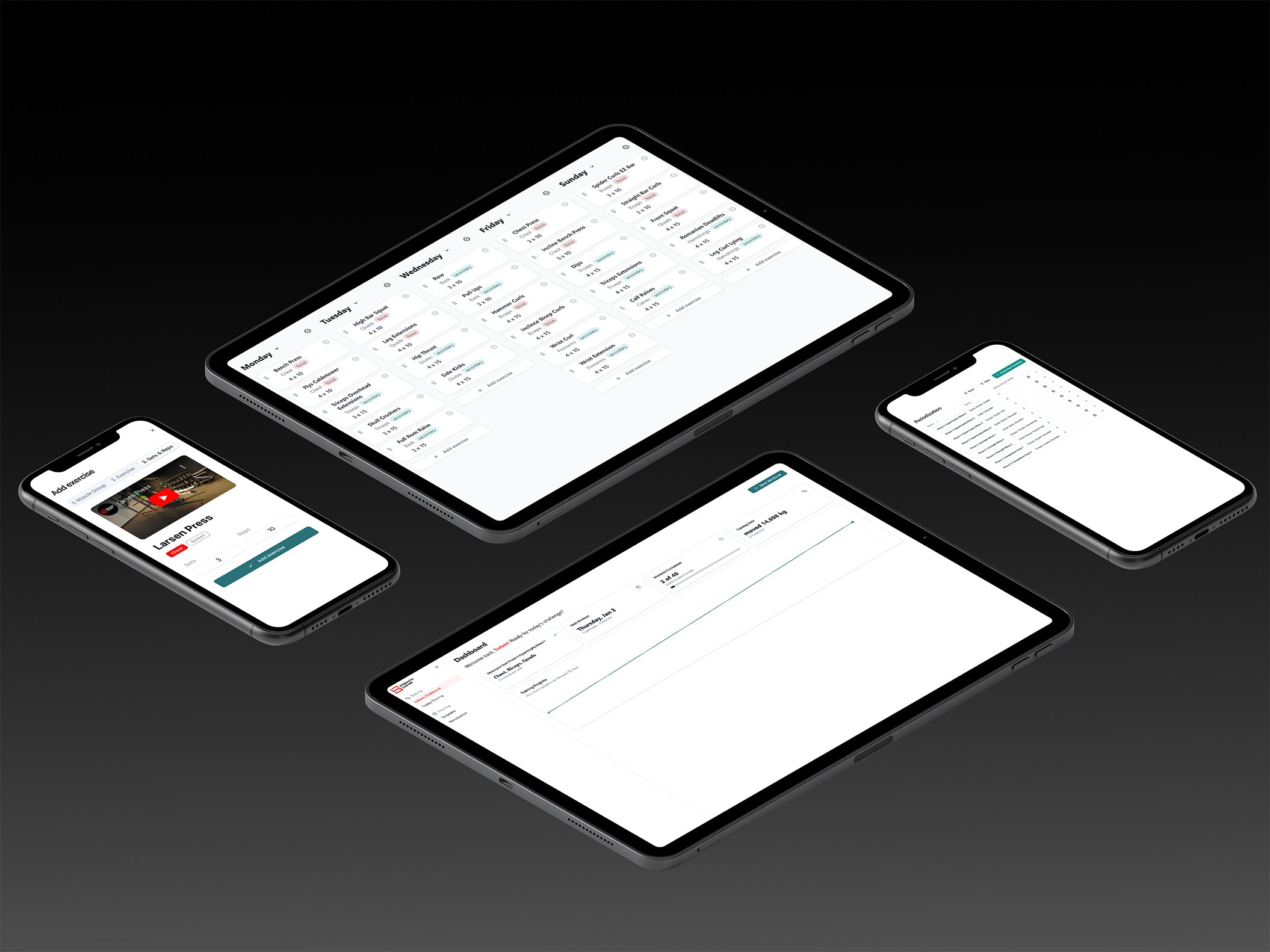Are you striving to optimize your squat 1RM but unsure where to start? This guide demystifies the process, providing a clear pathway to mastering your squat progress with the help of a science-based one rep max calculator. You will discover how to accurately determine your squat 1RM, the advantages of this knowledge, and techniques to enhance your one rep max safely. For those eager to elevate their strength training, calculate your 1RM now with our advanced calculator to start optimizing your lifts today.
Key Takeaways
- Proper warm-up and form are essential for accurate 1RM assessment and injury prevention
- Progressive overload and accessory exercises contribute to squat strength gains
- Rest and nutrition are foundational for recovery and improving squat performance
- Professional supervision is recommended during max testing for safety and technique refinement
- StrengthLab360’s app provides personalized squat one rep max calculations
Understanding the Science Behind Squat One Rep Max
Defining one’s squat one rep max is a cornerstone of strength training, serving as a benchmark for progress and a guide for exercise intensity. The journey to ascertain how to calculate one rep max for squat involves delving into muscle physiology and the intricacies of strength development. Various factors, from biomechanics to nutrition, influence the squat maximum. StrengthLab360’s squat one rep max calculator integrates these variables, offering athletes a precise tool to enhance their training regimen. calculate your 1RM now with our advanced calculator to start optimizing your lifts today!
Defining One Rep Max and Its Importance in Training
In the realm of powerlifting, the one rep max stands as the ultimate measure of an athlete’s maximal strength in exercises like the squat, deadlift, and bench press. This pinnacle weight, lifted in a single, all-out effort, not only benchmarks an individual’s current strength level but also informs the percentage-based training programs that are fundamental to progressive overload and strength gains. StrengthLab360’s precision tools enable athletes to calculate their squat one rep max, ensuring their training intensity is both challenging and appropriate for their capabilities. Calculate your 1RM now with our advanced calculator to start optimizing your lifts today!
Understanding one’s one rep max is crucial for athletes aiming to optimize their training outcomes. It acts as a compass, guiding weight selection across various exercises and enabling the tailoring of programs to individual strength levels. For instance, a powerlifter might use a percentage of their squat one rep max to structure training sessions, ensuring each set and rep is aligned with their strength-building objectives. calculate your 1RM now with our advanced calculator to start optimizing your lifts today! By leveraging StrengthLab360’s algorithmic insights, athletes can make informed decisions that propel them towards their peak performance.
Muscle Physiology and Strength Development
At the core of strength development lies muscle physiology, a complex process where muscle fibers adapt to the stress of resistance training. When an athlete performs a barbell squat, the body recruits muscle fibers to generate force against the weight. This action, underpinned by a well-calculated formula for load and repetitions, leads to muscular hypertrophy and strength gains. StrengthLab360’s app harnesses this science, providing athletes with data-driven training plans that align with their physiological responses. Calculate your 1RM now with our advanced calculator to start optimizing your lifts today!
The interplay between muscle tension, metabolic stress, and muscle damage during a heavy barbell squat is what propels strength and size advancements. To maximize these effects, athletes require a precise formula that considers their unique capabilities and adapts over time. StrengthLab360’s one rep max calculator is engineered to factor in these elements, offering a personalized approach to squat progression: calculate your 1RM now with our advanced calculator to start optimizing your lifts today!
- Input current performance data and training history.
- Receive a calculated one rep max based on proprietary algorithms.
- Implement the recommended weights and volumes in training sessions.
By integrating such a tailored system, athletes can ensure their efforts in the gym are both efficient and effective, leading to continuous improvement in their squat strength.
Variables That Influence Your Squat Maximum
The squat maximum is not solely a reflection of an athlete’s raw power; it is also shaped by biomechanical efficiency and neuromuscular coordination. An individual’s limb length, joint mobility, and muscle activation patterns play pivotal roles in the execution and outcome of a squat. StrengthLab360’s one rep max calculator takes these biomechanical nuances into account, offering a more personalized assessment that can significantly impact training strategies.
Nutritional status and recovery protocols are equally critical in determining the upper limits of one’s squat strength. Adequate protein intake, energy availability, and sleep quality can either bolster or hinder the body’s ability to repair and grow stronger after intense training sessions. The StrengthLab360 platform recognizes the importance of these variables, integrating them into its comprehensive analytics dashboard to provide athletes with a holistic view of factors affecting their squat performance.
How to Accurately Calculate Your Squat One Rep Max
Accurately determining one’s squat one rep max (1RM) is a multifaceted process that begins with proper physical preparation, including warm-up and mobility exercises. This guide will provide a step-by-step approach to conducting a 1RM test, methods for estimating 1RM through submaximal lifts, and strategies to avoid common errors during testing. Each section is designed to equip athletes with the knowledge to execute a 1RM assessment with precision, ensuring their training is informed by reliable strength metrics.
Preparing Your Body: Warm-Up and Mobility Exercises
Initiating a squat one rep max assessment with a comprehensive warm-up primes the body for peak performance, enhancing both safety and effectiveness. The athlete’s focus should be on elevating core temperature, lubricating joints, and activating the muscle groups integral to the squat. StrengthLab360 emphasizes the significance of dynamic stretches and light aerobic activity to prepare the body for the demands of a maximal lift, thereby reducing the risk of injury and improving neuromuscular efficiency.
Following the initial warm-up, targeted mobility exercises are essential for achieving the depth and stability required for an accurate squat one rep max calculation. StrengthLab360’s approach incorporates movements that enhance hip, ankle, and thoracic spine mobility, which are critical for executing a squat with proper form. This preparation ensures that the athlete’s performance reflects true strength capacity rather than limitations due to stiffness or poor movement patterns:
- Dynamic lower body stretches to increase range of motion.
- Ankle dorsiflexion drills for improved squat depth.
- Hip mobility sequences to facilitate proper alignment and force production.
- Thoracic extensions to support a strong, upright torso during the lift.
Step-by-Step Guide to Performing a 1RM Test
Embarking on a one rep max (1RM) test requires a methodical approach to ensure accuracy and safety. The athlete begins by performing squats with a weight that is comfortably manageable, gradually increasing the load in small increments. This stepwise progression allows the neuromuscular system to adapt and prepares the athlete for the maximal effort ahead. It is essential to rest adequately between attempts to maintain energy levels and prevent fatigue from skewing the results.
Once the warm-up sets are completed, the athlete approaches the 1RM attempt with focus and determination. It is critical to maintain proper form throughout the lift: feet shoulder-width apart, back straight, and core engaged. A spotter should be present for safety, providing assistance only when necessary. After successfully lifting the maximum weight, the athlete can input this data into StrengthLab360’s one rep max calculator to receive tailored training recommendations:
- Begin with manageable weights and progressively increase the load.
- Rest adequately between sets to prevent fatigue.
- Execute the 1RM attempt with correct form and a spotter for safety.
- Use the maximum weight lifted to calculate training loads with StrengthLab360’s calculator.
Estimating 1RM Using Submaximal Efforts
Estimating one’s squat one rep max (1RM) without reaching the point of maximal exertion is a strategic approach that minimizes risk while still providing valuable data. This method involves performing a set with a submaximal weight for as many repetitions as possible, which can then be input into StrengthLab360’s advanced calculator to estimate the 1RM. This approach is particularly beneficial for athletes who wish to avoid the stress of a maximal lift or are in a recovery phase.
The reliability of a submaximal effort to predict one’s 1RM hinges on the accuracy of the weight and rep data provided. StrengthLab360’s calculator uses this information to extrapolate an estimated 1RM, allowing athletes to plan their training without the need for a high-risk, maximal testing session. This method empowers athletes to maintain a clear trajectory towards their strength goals, ensuring that each training cycle is built on precise and actionable strength metrics.
Avoiding Common Pitfalls in 1RM Testing
One common pitfall in testing one’s squat one rep max (1RM) is the underestimation of warm-up’s impact on performance. Athletes must recognize that an inadequate warm-up can lead to suboptimal muscle activation and increased injury risk. StrengthLab360’s platform emphasizes the importance of a comprehensive warm-up routine, ensuring that users are physically primed to tackle their 1RM with maximum efficiency and safety.
Another frequent oversight is the neglect of proper technique in pursuit of heavier weights. This can not only skew the 1RM results but also pose significant injury risks. StrengthLab360 advocates for a strict adherence to form, even under maximal loads, to ensure the accuracy of the 1RM calculation and the athlete’s long-term health. To assist in this endeavor, the following steps should be meticulously followed:
- Engage in a thorough warm-up to prepare the body for heavy lifting.
- Adopt a gradual approach to increasing weights during the test.
- Maintain a focus on correct squat form throughout the assessment.
- Ensure adequate rest between sets to prevent fatigue from affecting the outcome.
- Utilize a spotter for safety during the maximal lift attempt.
Benefits of Knowing Your Squat One Rep Max
Understanding one’s squat one rep max (1RM) is pivotal for personalizing workout intensities and volumes, ensuring each athlete’s regimen is tailored to their unique strength capabilities. It serves as a foundation for tracking progress and setting performance goals, offering a clear metric for athletes to gauge their development. Moreover, a precise 1RM enables the crafting of targeted training programs, which are instrumental in enhancing athletic performance. These topics will be explored to demonstrate how athletes can leverage their 1RM for optimal training outcomes.
Personalizing Workout Intensities and Volumes
Accurate knowledge of one’s squat one rep max (1RM) is essential for customizing workout intensities and volumes, ensuring that each session is aligned with the athlete’s strength and hypertrophy goals. StrengthLab360’s one rep max calculator provides a scientific basis for these adjustments, enabling athletes to train with precision. Tailored intensities prevent undertraining and overtraining, optimizing the stimulus for muscle growth and strength enhancement.
By utilizing a one rep max calculator, athletes can establish a structured training plan that reflects their current capabilities and future aspirations. This strategic approach to workout design fosters progressive overload, a key principle in strength training that necessitates incremental increases in training stress. The following steps illustrate how to apply one’s 1RM to personalize their training regimen:
- Determine the squat one rep max using StrengthLab360’s calculator.
- Apply the calculated 1RM to set workout intensities for various training phases.
- Adjust volumes based on individual recovery rates and performance feedback.
With these personalized parameters, athletes can confidently engage in their strength training journey, knowing that each lift is a calculated step towards their peak performance. StrengthLab360’s platform ensures that these adjustments are not static but evolve with the athlete’s progress, maintaining the delicate balance between challenge and recovery.
Tracking Progress and Setting Performance Goals
Grasping one’s squat one rep max (1RM) is a critical step in charting progress and establishing clear, measurable performance goals. This quantifiable figure serves as a baseline from which athletes can measure improvements over time, providing a tangible indicator of strength gains. The StrengthLab360 platform facilitates this process by enabling users to track their 1RM evolution, fostering motivation and a sense of achievement as they witness their numbers ascend.
Setting performance goals becomes more strategic with an accurate understanding of one’s squat 1RM. Athletes can define realistic, yet challenging targets for strength enhancement, ensuring that each training cycle is purpose-driven and results-oriented. The StrengthLab360 app aids in this endeavor by offering a structured framework for goal-setting, which is grounded in the athlete’s current capabilities and informed by data-driven projections of their potential growth.
Enhancing Athletic Performance Through Targeted Training
Targeted training, informed by an accurate squat one rep max (1RM), is essential for enhancing athletic performance. By utilizing the StrengthLab360 one rep max calculator, athletes can pinpoint the precise intensities required for their workouts, ensuring each squat session contributes to their overall strength and power. This specificity in training not only maximizes efficiency but also significantly reduces the risk of injury, allowing for sustained progress in their athletic endeavors.
The practical application of a calculated 1RM equips athletes with the knowledge to structure their training cycles for optimal gains. For example, a bodybuilder might focus on hypertrophy by working at a percentage of their 1RM that stimulates muscle growth, while a powerlifter may train closer to their max to increase neuromuscular efficiency. The following table illustrates how different training goals can be aligned with corresponding percentages of the squat 1RM:
| Training Goal | Percentage of 1RM | Expected Outcome |
|---|---|---|
| Hypertrophy | 65-85% | Muscle Growth |
| Strength | 85-95% | Maximal Force Production |
| Endurance | 50-65% | Muscular Stamina |
| Power | 75-90% | Explosive Strength |
Utilizing a Science-Based Squat One Rep Max Calculator
Mastering the squat begins with precision, and a science-based one rep max calculator is the key to unlocking this accuracy. Athletes must input data correctly to ensure the calculator’s precision, interpret the results to inform their training, and integrate these insights into their workout plans. The subsequent sections delve into the specifics of each step, from data entry to actionable training strategies, providing athletes with a comprehensive guide to enhance their squat performance.
Inputting Data Correctly for Precision
Accurate data entry is the linchpin of utilizing the StrengthLab360 squat one rep max calculator effectively. Athletes must meticulously record their current performance metrics, including the weight lifted and the number of repetitions completed, to ensure the calculator’s algorithms provide precise training loads. This attention to detail in data input is crucial for tailoring strength programs that reflect an athlete’s true capacity and foster optimal squat progression.
The precision of the StrengthLab360 calculator hinges on the quality of the input from its users. When athletes input their exertion levels and training outcomes with accuracy, the platform’s algorithm can deliver customized recommendations that are essential for advancing squat strength. This process underscores the symbiotic relationship between athlete diligence and the sophisticated technology that StrengthLab360 offers, ensuring each training session is grounded in science and personalized for maximum efficacy.
Interpreting the Results to Inform Training
Interpreting the results from a one rep max calculator is a critical step for athletes seeking to refine their squat training regimen. The data provided by StrengthLab360’s calculator offers a detailed snapshot of an athlete’s current strength level, enabling them to adjust their training intensity and volume with precision. This personalized approach ensures that each squat session is calibrated to challenge the athlete without exceeding their limits, fostering sustainable progress and peak performance.
Upon receiving their calculated one rep max, athletes are equipped with the insights necessary to structure their strength training program effectively. The StrengthLab360 platform empowers users to translate these results into actionable training strategies, such as adjusting the weight for hypertrophy-focused workouts or preparing for powerlifting competitions. This tailored guidance helps athletes to avoid common training pitfalls and aligns their efforts with their specific fitness goals, leading to measurable improvements in their squat strength.
Integrating Calculator Insights Into Workout Plans
Integrating the insights from a science-based one rep max calculator into workout plans is a transformative step for athletes. The StrengthLab360 platform enables users to translate their calculated squat one rep max into a structured training regimen, ensuring that each session is meticulously aligned with their strength and hypertrophy objectives. This personalized approach to training not only enhances the efficacy of each workout but also accelerates the athlete’s journey towards their fitness goals.
For the athlete, the transition from raw data to a tangible workout plan is seamless with StrengthLab360’s intuitive interface. The platform’s recommendations, grounded in scientific precision, inform the athlete on how to adjust their squat loads and volumes for upcoming training cycles. This strategic integration of calculator insights ensures that every squat performed is a step towards optimal strength development, tailored to the individual’s unique physiological profile.
Techniques to Improve Your Squat One Rep Max
Enhancing one’s squat one rep max (1RM) is a multifaceted endeavor, requiring a strategic approach to training. Implementing progressive overload safely is essential for continuous strength gains, while accessory movements can provide the additional stimulus needed to boost squat strength. Furthermore, the role of rest and nutrition cannot be overstated, as they are foundational elements that support recovery and muscle growth. This section will delve into these critical techniques, offering practical guidance for athletes seeking to elevate their squat performance.
Implementing Progressive Overload Safely
Progressive overload is the gradual increase of stress placed upon the body during exercise training. For athletes seeking to enhance their squat one rep max safely, it is imperative to incrementally increase the weight lifted, ensuring that the body adapts to the heavier loads without succumbing to injury. StrengthLab360’s platform provides a structured approach to progressive overload, with real-time algorithmic adjustments that tailor training intensities to the athlete’s evolving strength levels.
Adhering to a science-based training plan is crucial for achieving consistent strength gains in the squat. The StrengthLab360 app offers periodized plans that systematically escalate training variables such as intensity, volume, and frequency, aligning with the athlete’s capacity for recovery and growth. This methodical progression is key to pushing the boundaries of one’s squat one rep max while maintaining a focus on long-term health and performance:
- Begin with a solid foundation of strength at a manageable intensity.
- Gradually increase the weight while monitoring the body’s response to ensure readiness for heavier loads.
- Utilize the StrengthLab360 app to adjust training variables in sync with personal progress and recovery needs.
Accessory Movements to Boost Squat Strength
Incorporating accessory movements into a strength training regimen is a strategic method to augment squat strength. These exercises target the synergistic muscles that support the squat, such as the glutes, hamstrings, and core, which are essential for a powerful lift. For instance, incorporating Romanian deadlifts and lunges can improve posterior chain strength, while hip thrusts directly enhance gluteal power, contributing to a more robust squat one rep max.
StrengthLab360 recognizes the value of accessory movements in developing a well-rounded squat technique. The platform suggests exercises like Bulgarian split squats and leg presses to address potential imbalances and strengthen stabilizing muscles. These movements, when integrated into a training plan, ensure comprehensive development and can lead to significant improvements in squat performance:
| Accessory Movement | Targeted Muscles | Contribution to Squat Strength |
|---|---|---|
| Romanian Deadlifts | Hamstrings, Glutes, Lower Back | Posterior Chain Power |
| Lunges | Quadriceps, Hamstrings, Glutes | Balance and Stability |
| Hip Thrusts | Glutes, Hamstrings | Gluteal Strength |
| Bulgarian Split Squats | Quadriceps, Hamstrings, Glutes | Unilateral Strength |
| Leg Presses | Quadriceps, Hamstrings, Glutes | Overall Leg Power |
The Role of Rest and Nutrition in Strength Gains
Rest and nutrition are pivotal in the quest for strength gains, particularly when improving one’s squat one rep max. Adequate recovery time allows for the repair and strengthening of muscle tissues stressed during intense workouts, while a diet rich in protein and essential nutrients supports this anabolic process. The StrengthLab360 platform underscores the significance of these elements, guiding users to optimize their rest periods and nutritional intake for maximal squat strength enhancement.
For the athlete dedicated to increasing their squat one rep max, understanding the synergy between rest, nutrition, and training is crucial. Strategic meal planning that aligns with workout schedules ensures the body is fueled and ready for the demands of heavy lifting, while quality sleep catalyzes muscle recovery and growth. StrengthLab360’s comprehensive analytics dashboard aids athletes in monitoring these aspects, ensuring their pursuit of a higher squat one rep max is supported by a solid foundation of rest and nutrition.
Safety Measures and Precautions During Max Testing
As athletes strive to master their squat technique using the StrengthLab360 one rep max calculator, safety remains paramount. Proper squat form is essential to prevent injuries, while attentiveness to one’s body helps avert overtraining. Professional supervision is recommended to ensure safety during max testing. These topics are critical for those seeking to enhance their squat strength without compromising their well-being.
Mastering Proper Squat Form to Prevent Injuries
Mastering proper squat form is a critical component in preventing injuries during maximal strength testing. Athletes must prioritize maintaining a neutral spine, engaging the core, and ensuring knees track over toes to safeguard against undue strain. StrengthLab360’s platform emphasizes the importance of these form fundamentals, providing users with technique analysis to refine their squat mechanics and bolster safety.
Executing a squat with meticulous attention to form not only minimizes the risk of injury but also maximizes the lift’s efficacy. The athlete’s focus on driving through the heels, controlling the descent, and powering up with a stable torso translates to a safer and more effective one rep max attempt. StrengthLab360’s real-time feedback and video analysis support athletes in achieving this level of technical proficiency, ensuring each squat is performed with optimal form.
Listening to Your Body to Avoid Overtraining
Heeding the body’s signals is essential in the pursuit of a higher squat one rep max, as it helps athletes avoid the detrimental effects of overtraining. The StrengthLab360 platform equips users with real-time algorithmic adjustments, ensuring training loads are optimized for individual recovery and growth. This personalized approach aids in recognizing when the body requires rest, preventing the onset of fatigue that could lead to training plateaus or injuries.
Overtraining not only stalls progress but can also reverse gains, making it crucial for athletes to listen to their bodies and adjust their training regimens accordingly. StrengthLab360’s comprehensive analytics dashboard provides insights into performance trends, enabling users to identify signs of overtraining early. By monitoring these metrics, athletes can make informed decisions about rest days and recovery strategies, maintaining a trajectory towards safely achieving their squat strength goals.
Seeking Professional Supervision When Necessary
When attempting to establish a squat one rep max, the guidance of a certified coach or experienced trainer is invaluable. These professionals can provide real-time feedback on form, offer adjustments to technique, and ensure that safety protocols are rigorously followed. StrengthLab360 encourages users to seek such supervision, particularly when new to max testing or when significant weight increments are introduced.
Professional oversight during max testing not only enhances safety but also instills confidence in the athlete. A trainer’s expertise can help identify when an athlete is prepared to attempt a new personal best, mitigating the risk of injury. For those utilizing the StrengthLab360 platform, this supervision complements the app’s algorithmic precision, creating a robust environment for strength progression:
- Assessment of readiness for max attempts by a professional.
- Immediate correction of form and technique during the lift.
- Ensuring adherence to safety measures throughout the testing process.
Conclusion
Mastering the squat through a science-based one rep max calculator is essential for personalized training, enabling athletes to train with precision and safety. By accurately determining one’s squat 1RM, athletes can tailor their workout intensities, track progress, and set realistic performance goals. Incorporating the insights from StrengthLab360’s calculator into workout plans ensures each session contributes effectively to strength and hypertrophy objectives. Ultimately, this approach empowers athletes to optimize their training outcomes, fostering continuous improvement and peak performance in their squat strength.
Frequently Asked Questions
What is the scientific basis for calculating a squat one-rep max?
The scientific basis for calculating a squat one-rep max lies in strength testing formulas that estimate maximal lift capacity from submaximal efforts, using variables like weight lifted and repetitions performed.
How can I determine my squat one rep max accurately?
To determine your squat one rep max accurately, perform a warm-up followed by gradually increasing weights until a single repetition reaches maximum effort, ensuring proper form and safety throughout.
Why is knowing my squat one rep max beneficial?
Knowing your squat one rep max is crucial for personalizing training intensity, tracking strength progress, and setting realistic, achievable goals in your powerlifting or bodybuilding journey.
Where can I find a reliable science-based one rep max calculator?
For a reliable one rep max calculator grounded in science, the StrengthLab360 App offers precision with real-time algorithmic adjustments tailored to your performance data.
What safety precautions should I take when testing my squat one-rep max?
Before attempting a squat one-rep max, ensure proper warm-up, use safety racks, maintain correct form, and have a spotter present to assist and ensure safety throughout the lift.

